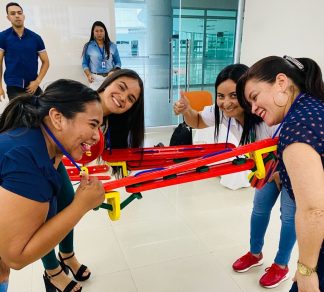You Need More than Lego for Really Serious Play
If you’ve used Lego Serious Play in training activities, then you know it can be a powerful way for people to express complex ideas in a simple way. But you can only go so far with LSP and if you’ve reached saturation point, you may be looking for something that explores the equally complex world of human behaviour, but in way that’s simple for everyone to grasp.
This article looks at experiential learning kits from MTa: an alternative tool that’s as easy to use as LSP, but is more about how we work, not just how we see work.
Missing Pieces
Many trainers use LSP as a way to get people sharing how they see things. But when it comes to putting those visions into practice, they need something else that deals with the way people interact.
Anyone can build a model, but what happens when people start working together with the same model: they add their own pieces or they start pulling it apart and breaking it. To see what really happens when people interact you need a tool like MTa’s experiential learning kits. These are designed to explore the relationships between the people involved.
Take change management. You could use LSP to help map out strategies and scenarios, then tweak and test them. But what happens when real people start living through that change? If you’re looking for something that shows you what really happens when leaders need to communicate vision and get people on board but people have different levels of engagement, then activities from MTa’s Insights and Team Kit are ideal.
Feel the Difference
Imagine your organization is facing a shake-up after a merger or acquisition. You put together an integration team to build the combined organization and use LSP so those on the team can share their own visions and agree on a way forward.
But then everyone goes back to work and carries on as normal — everyone is waiting for someone else to make the first move. A few are more enthusiastic and go out of their way to forge links with their new colleagues but others just carry on with their “day jobs”. This is all too common during any integration. How do you get the two different teams to work as one?
MTa has an activity called Digital Display that explores this. Members of a large group are each given a task that contributes to a bigger group task. But not everyone has all the equipment they need to complete the task and verbal communication isn’t allowed. Some complete their task early and are left hanging around. Others can’t complete their task and get frustrated.
One person is left as an observer who can switch places with anyone else. In successful teams, the observer role changes frequently giving everyone a greater chance to help visualize and solve the problem. It’s this kind of leader you need for an integration project: someone who can see everyone’s potential and opens doors to unleash it.
If you’re thinking of using LSP to help visualize your strategy, here are some more powerful tools that will help you understand the emotional dimensions that can be explored with experiential learning.
By Jamie Thompson, Managing Director of MTa Learning
MTa are experts in the field of experiential learning since 1982. We provide kits of experiential learning activities which are carefully designed. Our activities are fun, engaging and memorable – but effective too.
We also deliver MTa Facilitator Masterclasses for those Learning & Development professionals who want to ensure they capitalize on their investment in experiential learning.
Leading organisations around the world trust MTa with their Learning and Development requirements. If you’d like to find out more, please get in touch.

